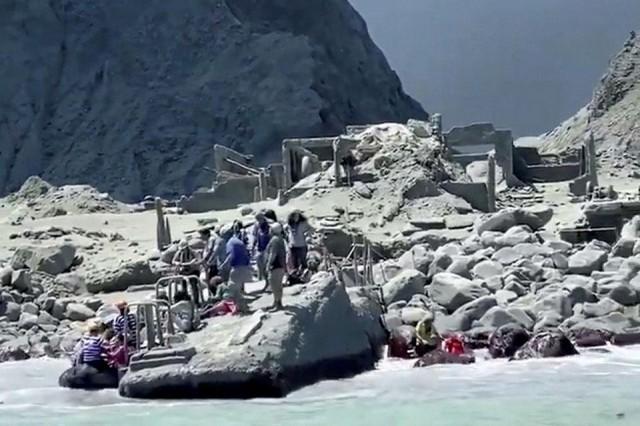‘Sudden’ volcano eruption in New Zealand kills at least 5; several missing

TAURANGA, New Zealand — At least five people were killed, up to 20 injured and several reported missing after a volcano that is a tourist attraction suddenly erupted off the coast of New Zealand's North Island on Monday.
More casualties were feared on White Island, where the volcano erupted at about 2:11 p.m. (0111 GMT, 9:11 a.m., PHL time), police said.
About 50 people, New Zealanders as well as foreign tourists, were feared to have been nearby and several were seen near the rim of the crater minutes before the eruption.
Many day tours visit the island regularly, and one from the Ovation of the Seas cruise liner was there at the time.
Twenty-three people were rescued, police said, adding that others were still on the island.
"We are unsure of the numbers and unsure of their well-being," deputy police commissioner John Tims told a news conference, adding that rescuers could not access the island because of risks, but without elaborating.
St. John Ambulance said up to 20 people were believed to have been injured in the eruption, adding that a mobile triage unit was on its way. The organization said it had sent seven helicopters to the island with medics onboard.
Michael Schade, an engineering manager from San Francisco, was one of the tourists who made it off the island just before the eruption.
In a video Schade posted on Twitter as he sped away from the island by boat, a huge plume of white ash soars into the sky as a group of frightened tourists huddles close to the shore.
"This is so hard to believe," Schade said. "Our whole tour group were literally standing at the edge of the main crater not 30 minutes before."
A crater rim camera owned and operated by New Zealand science agency GeoNet shows groups of people walking toward and away from the rim inside the crater, from which white vapor constantly billows, in the hour leading up to the eruption.
At 2:00 p.m. the crater rim camera catches a group of people—tiny specks in relation to the vast volcano—right at the edge of the rim. At 2:10 p.m.—just a minute before the eruption—the group is headed away from the rim, following a well-worn track across the crater.
White Island is about 50 km (30 miles) from the east coast of North Island and huge plumes were visible from the mainland. Volcanologists said the ash plume shot 12,000 feet (3,658 m) into the air.
"We know that there were a number of tourists on or around the island at the time, both New Zealanders and visitors from overseas," Prime Minister Jacinda Ardern told a news conference.
"I know there will be a huge amount of concern and anxiety for those who had loved ones on or around the island at the time. I can assure them that police are doing everything they can."
On Twitter, Australian Prime Minister Scott Morrison said Australians had been affected by the eruption and the government was trying to learn more. Twenty four Australians were on White Isand when the volcano erupted, Australian media said.
Kevin O'Sullivan, chief executive of the New Zealand Cruise Association, said: "We believe there is a tour party from Ovation of the Seas involved in the White Island eruption. We have no further details at the moment."
Ovation of the Seas is a 16-deck cruise ship owned by Royal Caribbean Cruises. It can take nearly 5,000 passengers and has a crew of about 1,500. It is docked at Tauranga, on the North Island, on a cruise that began in Sydney on Dec 3.
"We can confirm that a number of our guests were touring the island today," a company representative said in an emailed statement. "We do not have any additional details to share at this time."
No-fly zone
There seemed to be no danger for people in coastal areas farther away, authorities said.
The eruption was unexpected, but not unusual, an expert said.
"Sudden, unheralded eruptions from volcanoes such as White Island can be expected at any time," Shane Cronin, a volcanologist at University of Auckland, said in comments published by the Australia Science Media Centre.
"We know hydrothermal and so-called 'phreatic' eruptions can occur suddenly and with little or no warning because they are driven by the expansion of super-heated water into steam," he added.
Geological hazard tracker GeoNet raised the alert level for the White Island volcano in November due to an increase in volcanic activity.
Just last week, GeoNet volcanologist Brad Scott said in a report that moderate volcanic unrest continued at White Island, with substantial gas, steam and mud bursts observed at the vent located at the back of the crater lake.
The island's immediate surroundings were hazardous because of the eruption, the National Emergency Management Agency said in an statement, adding that falling ash might affect some areas.
The "short-lived eruption" showed no signs of escalating, New Zealand's geoscience agency GNS Science said in a statement.
The White Island volcano is one of New Zealand's most active.
The White Island volcano's last fatal eruption was in 1914, when it killed 12 sulphur miners. There was a short-lived eruption in April 2016.
White Island became a private scenic reserve in 1953, and daily tours allow more than 10,000 people to visit the volcano every year.
Whakaari, as it is known in Maori, is New Zealand’s most active cone volcano, built up by continuous volcanic activity over the past 150,000 years, according to geological hazard tracking agency GeoNet.
About 70 percent is under the sea, making the massive volcanic structure the largest in New Zealand. — Reuters





